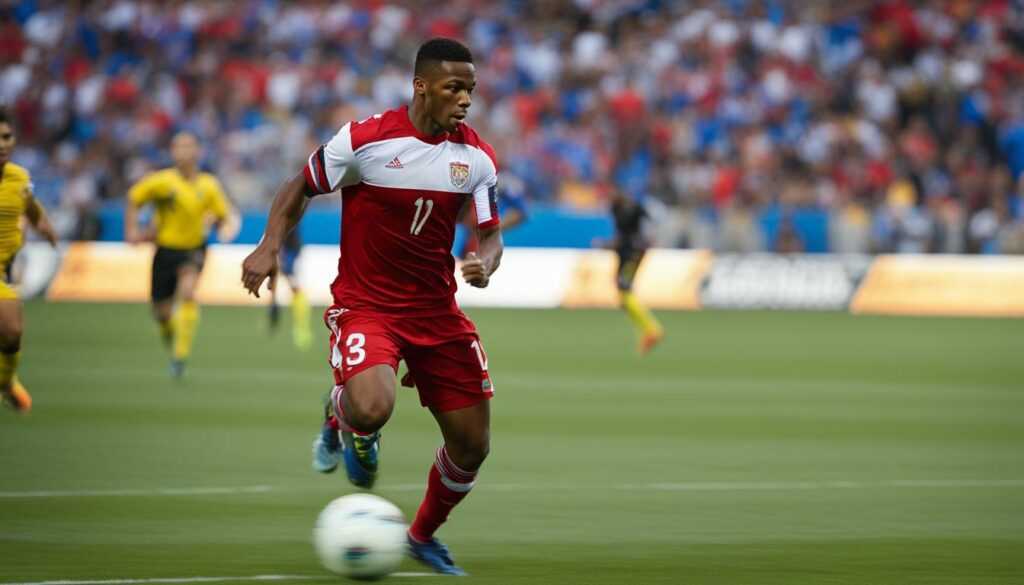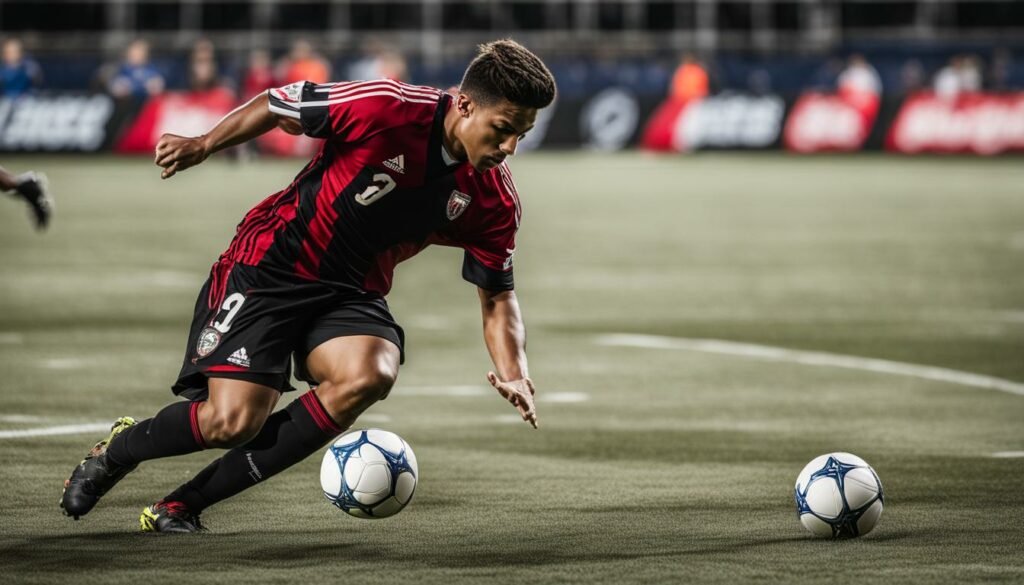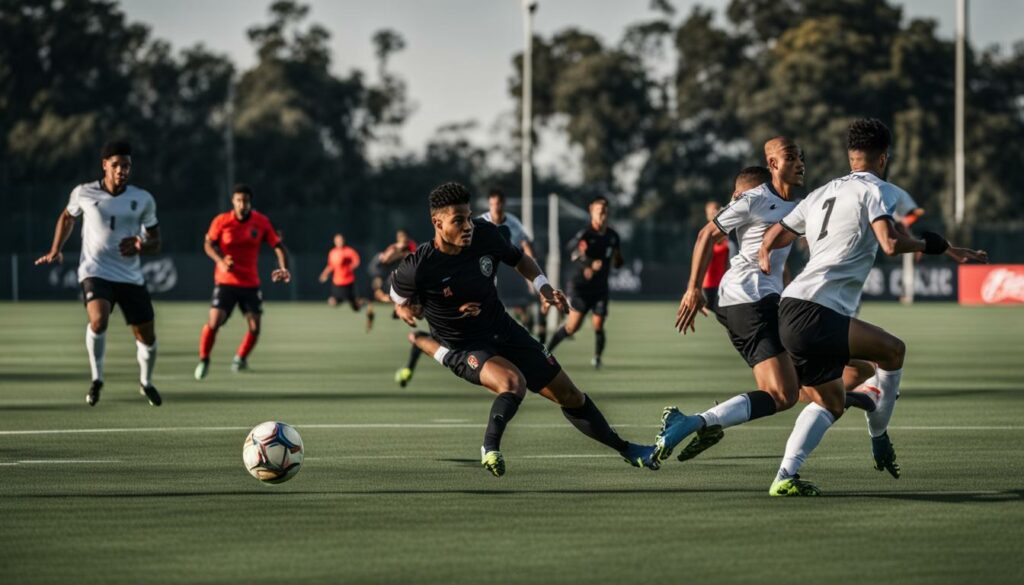The fullback position in soccer is a crucial defensive role that requires specific skills and strategies. By mastering the fullback position, players can elevate their game and become a defensive force on the field.
Key Takeaways:
- Mastering the fullback position is essential for elevating your game in
soccer . - The fullback position requires a balance of defensive skills and attacking prowess.
- Fullbacks defend against opposing attackers and contribute to the team’s attacking plays.
- Playing as a fullback requires technical, tactical, and physical skills.
- Modern fullbacks play a more prominent role in both defense and attack.
Responsibilities of a Fullback in Soccer
Fullbacks in
However, fullbacks also contribute to the team’s attacking plays. They provide width to the team’s formation and often overlap with the wingers to deliver crosses into the box. This requires good technical skills such as passing, crossing, and dribbling. Fullbacks are also expected to communicate well with their teammates, especially the wingers and midfielders they work closely with.
To summarize, the responsibilities of a fullback in
- Defending against opposing attackers
- Preventing goals
- Providing width to the team’s formation
- Overlapping with wingers and delivering crosses
- Having good defensive positioning, marking, and tackling skills
- Possessing technical skills such as passing, crossing, and dribbling
- Communicating effectively with teammates
By fulfilling these responsibilities, fullbacks contribute significantly to the team’s success and help elevate their game strategy on the field.
| Responsibilities | Skills |
|---|---|
| Defending against opposing attackers | Defensive positioning, marking, tackling |
| Preventing goals | Anticipation, interception, one-on-one defending |
| Providing width to the team’s formation | Overlapping, positioning |
| Overlapping with wingers and delivering crosses | Crossing, passing, timing |
| Having good defensive positioning, marking, and tackling skills | Defensive awareness, marking, tackling technique |
| Possessing technical skills such as passing, crossing, and dribbling | Passing accuracy, crossing technique, dribbling ability |
| Communicating effectively with teammates | Verbal and non-verbal communication, team coordination |
How to Play as a Fullback in Soccer
Playing as a fullback in
In terms of physical skills, fullbacks need good endurance and speed to cover the entire flank and assist in both attacking and defensive phases of play. This means maintaining a high work rate throughout the game and recovering quickly after making forward runs. Fullbacks often find themselves in 1v1 situations against opponents, so having the agility to change direction quickly and the strength to win duels is crucial.
Defensive Responsibilities
As a fullback, your primary responsibility is to defend against opposing attackers and prevent goals. This means staying compact with your center-backs and communicating effectively to ensure that there are no gaps in the defensive line. Anticipating the movements of the opposing team’s attackers will help you position yourself in the right place to intercept passes or make timely tackles.
Additionally, fullbacks must be aware of the movements of the opposing team’s wingers or wide players. This involves tracking their runs, closing down space quickly, and limiting their options for crossing or shooting. By being diligent in your defensive duties, you can help your team maintain a strong defensive structure and limit the effectiveness of the opposition’s attacks.

The Attacking Fullback in Soccer
When it comes to the fullback position in
Attacking fullbacks make overlapping runs, providing width to the team’s formation and stretching the opposition’s defense. They often have excellent crossing abilities and a strong sense of timing to join the attack immediately. By venturing forward, they create scoring opportunities for their team while maintaining defensive discipline.
As a result, attacking fullbacks contribute with goals and assists, acting as an additional attacking outlet for the team. Their ability to create opportunities and contribute offensively adds a valuable dimension to the team’s overall strategy.
The Defensive Fullback in Soccer
Regarding the fullback position in
Defensive fullbacks rely on their physical strength, good positioning, and the ability to read the game well. They understand the importance of maintaining a strong defensive structure to prevent the opposition from scoring. Whether it’s clearing the ball from dangerous areas or tracking back to neutralize attacking threats, defensive fullbacks are reliable and crucial contributors to their team’s defensive solidity.
To illustrate the impact of defensive fullbacks, consider the following table showcasing their defensive statistics:
| Player | Tackles Won | Interceptions | Clearances |
|---|---|---|---|
| Player A | 32 | 18 | 24 |
| Player B | 28 | 20 | 26 |
| Player C | 35 | 16 | 22 |
As seen in the table, these defensive fullbacks consistently contribute to their team through tackles won, interceptions, and clearances. Their performances demonstrate their defensive prowess and highlight their essential role in protecting the team’s goal.

Key Attributes of a Defensive Fullback
- Physical Strength: Defensive fullbacks should possess the physical strength to hold off opposing players and win aerial duels.
- Positioning: They require good defensive positioning to anticipate and intercept passes, as well as effectively mark opposing players.
- Reading the Game: The ability to read the game allows defensive fullbacks to make quick decisions and react to different attacking scenarios.
- Communication: They must have strong communication skills to coordinate with their teammates and ensure effective defensive organization.
Overall, defensive fullbacks play a vital role in a team’s defensive structure and provide the necessary defensive solidity. With their physicality, positioning, and reading of the game, they contribute significantly to their team’s success.
Tips to Improve as a Fullback in Soccer
Improving as a fullback in
1. Enhance your Defensive Positioning
Defensive positioning is crucial for a fullback to defend against opposing attackers effectively. Work on your awareness of the game, learn to read the movements of the opposition, and position yourself in a way that allows you to intercept passes and make timely tackles. A well-positioned fullback can deny goal-scoring opportunities and provide a solid defensive foundation for the team.
2. Improve your Tackling Technique
Tackling is a key skill for fullbacks, and mastering different types of tackles will make you a more versatile defender. Practice various tackling techniques such as slide, standing, and block tackles. Focus on timing and execution to ensure clean and effective challenges, while minimizing the risk of fouls or giving away penalties.
3. Develop your Attacking Skills
Fullbacks are not only responsible for defending but also for contributing to the team’s attacking plays. Work on your crossing, passing, and shooting abilities to become a threat in the attacking third. Practice delivering accurate crosses into the box, creating scoring opportunities for your teammates, and even scoring goals yourself. The ability to contribute offensively will make you a more well-rounded fullback.
Remember that improvement comes with consistent effort and a willingness to learn. Seek feedback from your coaches and teammates, analyze your performances, and work on your weaknesses. By continually honing your skills and embracing a growth mindset, you can become a standout fullback in

The Importance of Versatility for Fullbacks in Soccer
Versatility is a highly valued trait for fullbacks in
Fullbacks who can contribute equally effectively on both sides of the field provide crucial depth and flexibility to the team’s defense. They can seamlessly switch positions during a game, confusing the opposition and creating more opportunities for their team. A versatile fullback can seamlessly adjust to different formations and strategies, making them an invaluable asset to any team.
The Advantages of Versatile Fullbacks
- Defensive Stability: When a fullback is injured or unavailable, a versatile fullback can fill in seamlessly on either side of the defense, maintaining the team’s defensive stability.
- Tactical Flexibility: Versatile fullbacks allow the coach to switch formations or adjust their game plan based on the opposition or specific game situations.
- Attacking Options: Fullbacks who can play on both sides of the field provide more attacking options for their team. They can support both wingers, overlapping on either side to create more crossing and scoring opportunities.
- Squad Depth: Having versatile fullbacks increases squad depth and gives teams more options in their squad selection. This helps manage player workload, prevents fatigue, and provides the opportunity to rest key players without compromising the team’s defensive strength.
In conclusion, being a versatile fullback in
Conclusion
Mastering the fullback position in
Playing as a fullback in
The role of fullbacks in
Players can focus on enhancing various aspects of their game to improve as a fullback in
